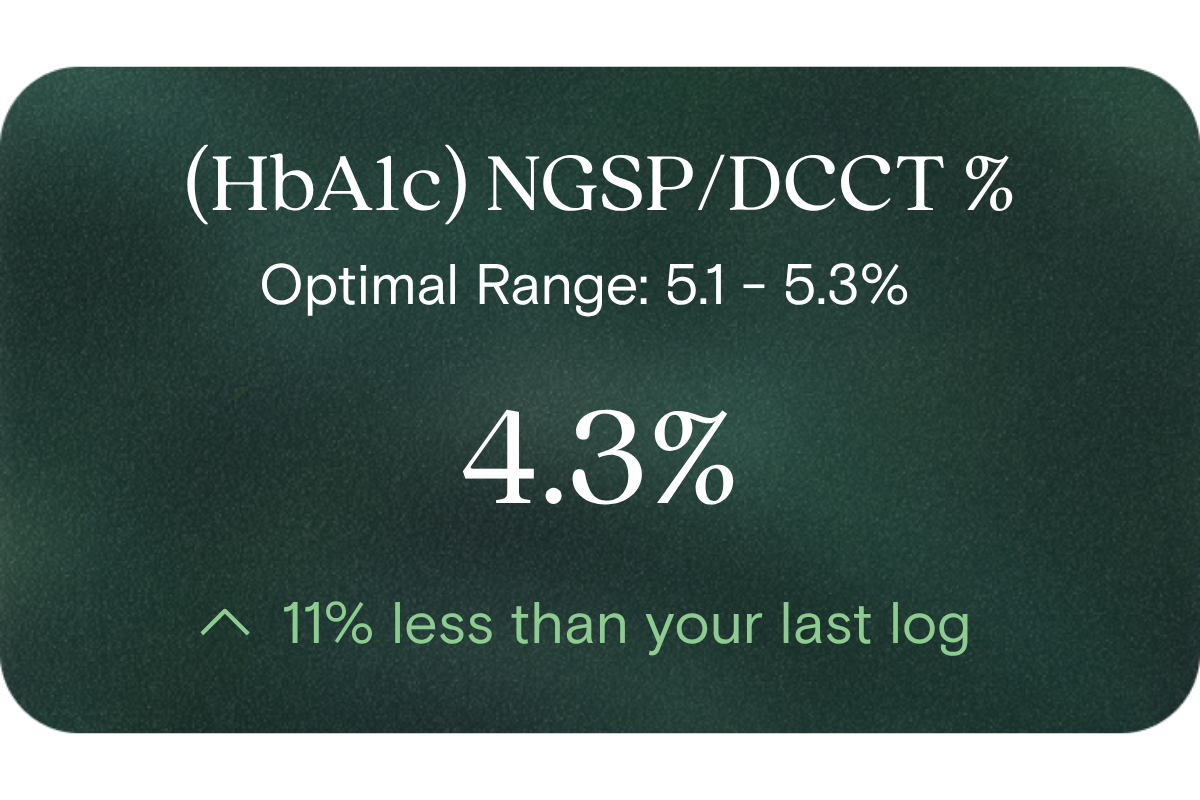What is Haemoglobin A1c (HbA1c)?
It is the percentage of haemoglobin (in red blood cells) that has glucose attached (i.e. glycation). Because red blood cells have an average lifespan of about 120 days, HbA1c reflects your average blood glucose exposure over the prior 8–12 weeks.
Why does it matter for long-term health and wellbeing?
Your HbA1c tracks your medium-term glycaemic load — that is, how “hard” your metabolic system is working to buffer glucose over months. A lower and more stable HbA1c suggests smoother metabolic balance, better energy efficiency, and lower strain on insulin signalling and related tissues. Over time, higher HbA1c is associated with more wear (oxidative stress, glycation damage) on organs and vascular systems. Thus, HbA1c serves as a guiding metric for healthy ageing and preventive optimisation.
What’s an optimal level of HbA1c?
- Reference / typical lab (low–high) range: 4.0 % to 5.7 % (though many labs accept up to ~6.0 %)
- Vively’s “optimal” target range: 5.1 % to 5.3 %
If your value is below 4 %, it might suggest unusually low glycaemic load (rare) or issues such as anaemia. If it’s above 5.7 %, that signals your average glucose is creeping above ideal balance, and you may want to take action earlier.
What influences HbA1c levels?
Many modifiable and non-modifiable factors, including:
- Daily glycaemic exposures (meals, snacking, carbohydrate quality)
- Insulin sensitivity (muscle, liver, adipose tissue)
- Physical activity and muscle glucose uptake
- Sleep, circadian rhythm, stress hormones
- Body composition (especially visceral fat)
- Red blood cell turnover or lifespan (e.g. iron deficiency or anaemia can falsely raise HbA1c)
- Conditions or factors that alter haemoglobin structure or erythrocyte turnover (haemoglobin variants, bleeding, recent transfusion)
- Lipid metabolism and inflammation (some studies show links between triglycerides, cholesterol and HbA1c)
What does it mean if HbA1c is outside the optimal range?
If your HbA1c is above 5.3 % (especially approaching or exceeding 5.7 %), it means your average glycaemic load is trending upward relative to your ideal. This doesn’t mean there’s a diagnosis, but it is a signal: your metabolic system is working harder, and there’s less “buffer room.” That is an opportunity to refine diet, activity, sleep or stress resilience. If your HbA1c is below 5.1 %, that suggests strong metabolic efficiency — though if very low (below 4 %) it might merit evaluation for influences such as anaemia or altered red blood cell dynamics.
How can I support healthy HbA1c levels?
- Focus on low-glycaemic whole foods and balanced macronutrients (especially fibre, protein, healthy fat)
- Prioritise regular movement, especially resistance / strength work, which helps insulin sensitivity
- Ensure good sleep quality and consistency
- Manage stress, circadian alignment, and avoid chronically elevated cortisol
- Monitor and correct any iron deficiency or conditions affecting red blood cell health
- Use the feedback: retest every few months to track response to your interventions
This information is provided for general health and wellness purposes only and does not replace medical advice.
References
- Royal College of Pathologists of Australasia. (n.d.). RCPA Manual: Haemoglobin A1c (HbA1c).
- Australian Diabetes Society. (2023, May). Guidance concerning the use of glycated haemoglobin for the diagnosis of diabetes mellitus.
- Monash Health Pathology. (n.d.). Reference Intervals Master List.




















.png)
